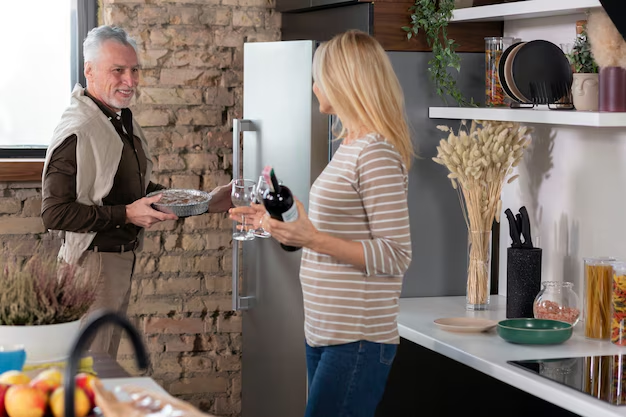The Ideal Refrigerator Temperature: Keeping Your Food Fresh and Safe
When it comes to food storage, setting your refrigerator to the right temperature is crucial. Understanding the standard refrigerator temperature can help keep your food fresh longer and prevent the growth of harmful bacteria. Let's delve into the details of maintaining the perfect temperature for your refrigerator, along with additional tips on fridge management and common challenges.
The Ideal Refrigerator Temperature
A standard refrigerator temperature should generally be set at or below 40°F (4°C). Most experts agree that this is the optimal range to keep food safe without freezing it inadvertently. Maintaining this temperature helps thwart the growth of microorganisms that can cause foodborne illnesses.
Knowing the Ideal Temperature for Different Refrigerators
It's important to acknowledge that different types of refrigerators may have slightly varying ideal temperature settings:
- Standard Home Fridges: Typically programmed to the 37°F (3°C) to 40°F (4°C) range.
- Mini Fridges: These smaller units can fluctuate more and should ideally be set closer to 37°F (3°C) to help maintain a stable temperature.
- Commercial Refrigerators: Often kept between 36°F (2°C) and 38°F (3°C) for optimal food preservation in larger storage volumes.
Factors Affecting Refrigerator Temperature
External Environment
The surrounding room temperature can greatly impact the efficiency of your refrigerator. In warmer climates or during the summer months, fridges may need to work harder, meaning adjustments to the thermostat might be necessary to maintain the preferred internal temperature.
Placement and Design
Where you place your refrigerator matters. Avoid setting it near heat sources such as ovens or direct sunlight, which could cause fluctuating internal temperatures. Additionally, ensure there is adequate space around the fridge for ventilation, enhancing its ability to dispense heat effectively.
Refrigerator Design
Fridge designs vary, and some may have features that affect temperature control:
- Single-door vs. Double-door: Single-door fridges often have a smaller freezer space, potentially affecting the overall temperature balance.
- Built-in Thermometers: While convenient, always cross-verify with an external thermometer to ensure accuracy.
How to Check and Adjust Your Fridge Temperature
Using a Refrigerator Thermometer
A dedicated refrigerator thermometer is a helpful tool for ensuring your appliance maintains the correct temperature. Place it near the door, where temperatures undergo the most variation, and ensure the reading aligns with your fridge’s thermostat setting.
Adjusting the Thermostat
If your refrigerator isn't maintaining the ideal temperature, it may be time to adjust the thermostat:
Locate the Dial: Most models feature a dial inside the fridge, often marked with numbers from 1 to 5 or 1 to 7.
Incremental Changes: Make small adjustments and allow at least 24 hours for the fridge to stabilize before re-checking the temperature.
Monitor Regularly: Regular checks help in early detection of issues like a malfunctioning thermostat or compressor.
Maintenance Tips for Optimal Performance
- Regular Cleaning: Dust and clean the coils at the back of your refrigerator to ensure efficiency.
- Seal Checks: Inspect door seals regularly and replace if they’re worn to prevent cold air leaks.
- Avoid Overcrowding: Allow space between items and shelves for air to circulate freely, maintaining consistent temperatures.
Common Refrigerator Temperature Issues
Uneven Cooling
Uneven temperatures can occur if air circulation is restricted, often due to overcrowding of shelves or blocked vents. Redistributing items can help improve airflow.
Ice Build-up
Excessive ice formation might indicate a faulty door seal or thermostat. Regular defrosting and seal maintenance could prevent such issues.
Persistent Warm Spots
Verify that warm spots aren't the result of leaving the door open frequently or storing hot food directly inside the fridge.
Helpful Key Points to Remember
🔑 Quick Tips for Refrigerator Management:
- Set temperature to 37°F (3°C) to 40°F (4°C).
- Verify with a separate thermometer for accuracy.
- Ensure proper ventilation and avoid heat sources.
- Regularly clean and check seals for efficiency.
Final Takeaway
Maintaining the correct refrigerator temperature is fundamental for food safety and preserving freshness. By understanding the ideal conditions and keeping abreast of maintenance best practices, you can ensure your fridge functions efficiently year-round. Staying vigilant with regular checks and adjustments can make all the difference in preventing food spoilage and promoting a healthy home environment.
Ultimately, a well-maintained refrigerator is key to effective food storage, reducing food waste, and potentially saving on electricity bills. Keep these tips and considerations in mind, and you'll be well-equipped to manage your refrigerator like a pro.
